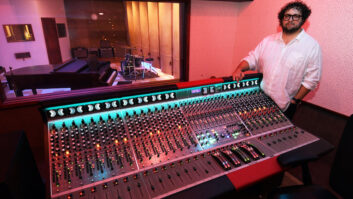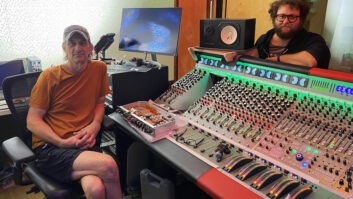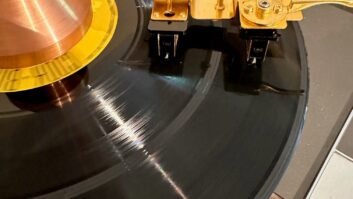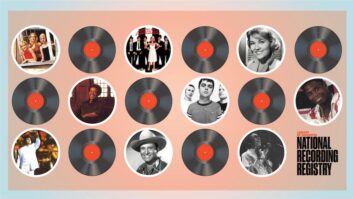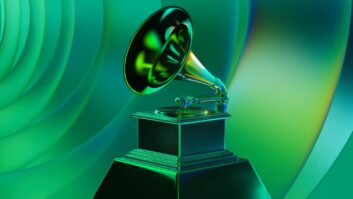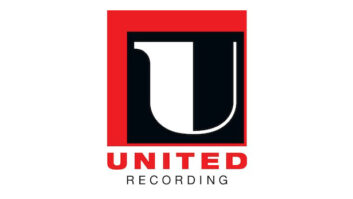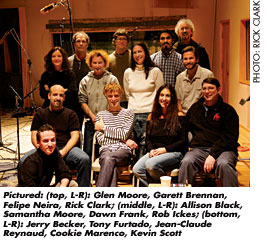
The dusk outside the Marin County, Calif., studio The Site wasmagical, with deep reds, oranges and grays mixed with clouds, mist frombillowing coastal overcast drifting in and redwood trees toweringoutside the tracking room windows. Inside, Glen Moore, of the legendaryacoustic fusion band Oregon, was improvising his own magic on his300-year-old Klotz string bass. Its rich tonality filled the room,while an impressive complement of precisely placed microphones capturedhis performance. When I walked into the control room, it sounded likeMoore was in the middle of the Neve console, and when I walked aroundthe room, the bassist’s position hadn’t changed. Standing outside thearray of Jean-Marie Reynaud speakers were producer/engineers CookieMarenco and Jean-Claude Reynaud. After listening for a few minutes,Marenco exclaimed, “No bad seats!” She was right.
What I listened to were the fruits of almost two years of work, inwhich Marenco and Reynaud pursued a surround production approach thatwould bring a sound to live performance — oriented recordingsthat is intimate and expansive. They call this trademarked techniqueESE, or Extended Sound Environment.
Marenco is no stranger to audiophile-level production andengineering, having worked with some of the music world’s most creativetalents and consulted for a number of innovative manufacturers. Shealso worked in A&R at Windham Hill, where five albums she producedearned Grammy nominations. Her production credits include Winter’sSolstice Vol. 2 (which went Gold), Ladysmith Black Mambazo, PaulMcCandless (of the band Oregon), Turtle Island String Quartet, TonyFurtado and Alex Di Grassi. As an engineer, she has recorded manyartists, including Mary Chapin Carpenter, Praxis, the Charlie Haden’sQuartet West and Max Roach.
The odyssey that led Marenco’s sessions at The Site began a fewyears ago, after she became frustrated by the record industry’spuzzling acceptance of MP3 audio and overly compressed recordings. Shetook a three-month break to figure out what would make her happy, andif she even wanted to go back into the studio. “I knew that I hadto go back in with a partner,” says Marenco. “I neededsomebody who would motivate me to love music and soundagain.”
A trip to attend a wedding in France changed things for her. There,Marenco spotted some Schoeps microphones used during the reception andwas curious about who would use such fine mics for such an application.That’s when Marenco encountered Reynaud. “I had learned a veryclassical kind of recording from great old-school engineers in France,and it seemed that everything I had learned was being thrown away bydigital sound,” says Reynaud (whose father manufactures theaudiophile JM Reynaud speakers in France).
Marenco immediately realized that she and Reynaud shared many of thesame feelings about audio. A few weeks later, the two began checkingout surround audio setups at the 2002 AES Convention and, by and large,were somewhat disappointed by what they heard. They started tovisualize ways to make multichannel recording more natural andsatisfying. They booked time at The Site in December 2002 and began aseries of surround recording experiments, aided by the generous help ofSony, Millennia, Pass Labs, JM Reynaud and Stephen Jarvis (who lentthem an extensive collection of Didrik deGeer microphones).
After trying many mic and speaker configurations, Sony’s Gus Skinnassuggested that the ITU layout [see diagram] might best-suit theirgoals. Not only did they utilize the ITU setup for the listeningenvironment, they also echoed it exactly with microphone setups in thetracking space and in 19×13×17 live chamber. Additionalclose-miking was applied for the musicians. The session proved to beenlightening, and the team reconvened at The Site in December 2003.
“The ESE technique uses a combination of mic placement in thetracking room that is an ITU configuration in front of the musicians,in addition to close mic positions for a more ‘direct’sound from the instrument. We find the combination of close androom-miking more pleasing than using one and not the other, as well asproviding an alternative to surround listening,” says Marenco.“Surround listening offers only one ‘optimum’listening position: in the center of the five channels. Our techniqueis designed to have a three-dimensional approach to multichannellistening and offers the listener the ability to listen outside thespeaker circle and walk ‘through’ the speakers and in thecenter.
“The results are dependent on the quality of the microphones,speakers, preamps, speaker cable, recorder and effects used,”Marenco continues. The team recorded to 2-inch analog Studer A-800,with Dolby SR at 15 ips. The 5.1 mixdown was to a Sony Sonoma 1-bit DSDsystem; stereo mixdown was to the Sonoma system and a half-inch analogStuder A-80 with Dolby SR at 15 ips. This chain was also used as backupto the Sonoma system for 2-track editing.
The entire recording was done on TheSite’s Neve 8078 console, whichhas 72 inputs and is modified for surround monitoring and mixdown,important to the ESE process. The signal was bused out to the Sonomawith Ed Meitner converters, recorded in DSD 1-bit and returned to theconsole with a 6-channel monitor section to Nelson Pass amps, whichwere wired with JM Reynaud silver cable to Offrande JM Reynaud speakers(single-wired) and a JM Reynaud Furioso self-powered sub.
“Because of the delicate phase issues created, we used onetrack for every mic used,” says Marenco. “For our initialexperiments, we intentionally kept the ensembles to duos and soloperformances, with no option for overdubs. This led to our choice ofexceptional musicians capable of great live performances andinteractive dynamics. The use of headphones is not an option at thistime.
“The choice of 1-bit recording and avoiding the use of PCMdigital also led us to not use digital effects, instead choosingto use the chamber for additional reverb,” Marenco adds.“We miked the chamber in the ITU configuration with two to fourspeakers placed inside with individual sends from the board. We usedvery minimal compression on some of the direct mics on mixdown only.However, we realized the issues [that were] created with compressionand only used it sparingly — if at all.”
For the tracking sessions, Marenco and Reynaud used five DPA orB&K 4003 mics and the Millennia 8-channel HV-3D mic preamp. All ofthe room mics were set facing up about 45 degrees toward the outsidewalls. Two DPA 4041s were used to close-mike the guitars and wereplaced about eight inches from the instrument pointing 45 degrees fromthe sound hole. Didrik deGeer mics, paired with Neve preamps from theconsole, were used for vocals and set about 24 inches from the singers.Only one DPA 4041 mic was used on guitars when a vocal was alsorecorded. For dobro, two DPA 4011s in an X/Y configuration about 24inches above the instrument were used. For Moore’s acoustic bass, a DPA4041 was placed on top where the neck meets the body of the bass and aDidrik deGeer mic on bottom in front of the bridge, both mics throughMillennia preamps.
Subsequent mixdowns were done at The Site and nearby SkywalkerSound; Skywalker mixdowns were done on their new 72-input Neve 88Rsurround console. The 80×60×30 scoring stage was used as thereverb chamber, and the ITU was enlarged to accommodate the largerspace.
The feedback from the session players was most rewarding. “Themusicians said that the recordings really sounded like them: ‘Itwas not the sound of a guitar. It was the sound of my guitar. Itwasn’t the sound of a voice. It is the sound of myvoice,’” says Reynaud.
Marenco enthusiastically agrees: “After four albums producingTony Furtado, he came in and said, ‘Cookie, you finally got mybanjo sound!’ I thought, ‘Was this what I had to do to getyour banjo sound: seven mics, a chamber and a 5.1 setup?’”she says with a laugh.
While the team was committed to the concept of no compromise withthe equipment used, they were bound by the most important aspect of theundertaking — the event’s emotional spirit. The striking intimacyand enveloping ambiences of the ESE recordings were most interesting inthat they seemed to highlight the chemistry between the players evenmore so than before.
“You are capturing that moment in time, and that moment intime is about the vibe,” Marenco says. “We tried puttinggreat musicians with each other who didn’t have that friendship fromyears and years of playing together and it didn’t quite work. Werealized that they needed to be friends on a musical level, because ourtechnique was going to enhance that dynamic or lack of dynamic. When itworked, it was an amazing experience to see it come to life.”
Encouraged by the team from Sony, Marenco decided to create BlueCoast Records; its first release will be a compilation of these ESErecordings available in SACD 5.1, SACD 2-track and CD-format hybriddisc in the fall of 2004. Marenco and Reynaud plan to continueexperimenting with ESE and other innovative technologies that bring theartist’s performances and vibe into the listener’s home.
“Most people haven’t heard this kind of sound in so long thateven when we bring out our 2-track stereo mixes of these sessions,people say, ‘Wow!’ It invites people to listen,”Marenco concludes. “It seems that people have stopped listeningand are using music like wallpaper. It’s part of the reason that themusic industry is in a shambles. The way that much of the music isrecorded now, it lacks emotion. The current fashion is to beover-compressed and to hit everything as loud as possible. It’shorrible and we don’t want to support it any more. We see ESE as anopportunity to bring back the beauty of real sound — the sense ofreal emotion — and that comes from dynamics and greatvibes.”


